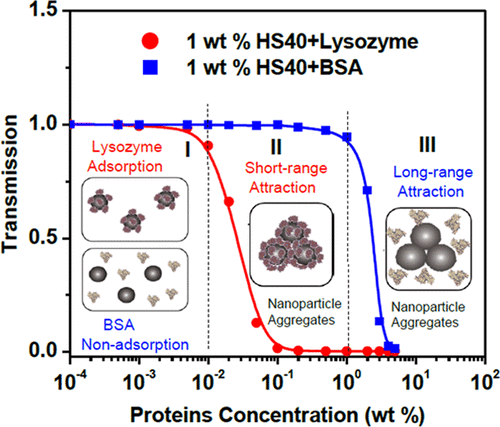Our official English website, www.x-mol.net, welcomes your
feedback! (Note: you will need to create a separate account there.)
Structure and Interaction of Nanoparticle–Protein Complexes
Langmuir ( IF 3.7 ) Pub Date : 2018-04-19 00:00:00 , DOI: 10.1021/acs.langmuir.8b00110 Sugam Kumar 1 , Indresh Yadav 1, 2 , Vinod Kumar Aswal 1, 2 , Joachim Kohlbrecher 3
Langmuir ( IF 3.7 ) Pub Date : 2018-04-19 00:00:00 , DOI: 10.1021/acs.langmuir.8b00110 Sugam Kumar 1 , Indresh Yadav 1, 2 , Vinod Kumar Aswal 1, 2 , Joachim Kohlbrecher 3
Affiliation

|
The integration of nanoparticles with proteins is of high scientific interest due to the amazing potential displayed by their complexes, combining the nanoscale properties of nanoparticles with the specific architectures and functions of the protein molecules. The nanoparticle–protein complexes, in particular, are useful in the emerging field of nanobiotechnology (nanomedicine, drug delivery, and biosensors) as the nanoparticles having sizes comparable to that of living cells can access and operate within the cell. The understanding of nanoparticle interaction with different protein molecules is a prerequisite for such applications. The interaction of the two components has been shown to result in conformational changes in proteins and to affect the surface properties and colloidal stability of the nanoparticles. In this feature article, our recent studies exploring the driving interactions in nanoparticle–protein systems and resultant structures are presented. The anionic colloidal silica nanoparticles and two globular charged proteins [lysozyme and bovine serum albumin (BSA)] have been investigated as model systems. The adsorption behavior of the two proteins on nanoparticles is found to be completely different, but they both give rise to similar phase transformation from one phase to two phase in respective nanoparticle–protein systems. The presence of protein induces the short-range and long-range attraction between the nanoparticles with lysozyme and BSA, respectively. The observed phase behavior and its dependence on various physiochemical parameters (e.g., nanoparticle size, ionic strength, and solution pH) have been explained in terms of underlying interactions.
中文翻译:

纳米粒子-蛋白质复合物的结构和相互作用
纳米粒子与蛋白质的整合由于其复合物所展现的惊人潜力而具有很高的科学兴趣,结合了纳米粒子的纳米级特性与蛋白质分子的特定结构和功能。纳米粒子-蛋白质复合物尤其可用于纳米生物技术的新兴领域(纳米医学,药物递送和生物传感器),因为具有与活细胞相当大小的纳米粒子可以进入并在细胞内运行。了解纳米粒子与不同蛋白质分子的相互作用是此类应用的先决条件。已显示两种组分的相互作用导致蛋白质的构象变化,并影响纳米颗粒的表面性质和胶体稳定性。在这篇专题文章中,我们最近的研究提出了探索纳米粒子-蛋白质系统中的驱动相互作用和最终结构的方法。阴离子胶体二氧化硅纳米颗粒和两种球形带电蛋白[溶菌酶和牛血清白蛋白(BSA)]已作为模型系统进行了研究。发现两种蛋白质在纳米粒子上的吸附行为完全不同,但是它们各自在各自的纳米粒子-蛋白质系统中引起相似的从一相到两相的相变。蛋白质的存在分别诱导了纳米颗粒与溶菌酶和BSA之间的近距离和远距离吸引。已观察到的相行为及其对各种物理化学参数(例如,纳米粒子大小,离子强度和溶液pH)的依赖性已根据潜在的相互作用进行了解释。
更新日期:2018-04-19
中文翻译:

纳米粒子-蛋白质复合物的结构和相互作用
纳米粒子与蛋白质的整合由于其复合物所展现的惊人潜力而具有很高的科学兴趣,结合了纳米粒子的纳米级特性与蛋白质分子的特定结构和功能。纳米粒子-蛋白质复合物尤其可用于纳米生物技术的新兴领域(纳米医学,药物递送和生物传感器),因为具有与活细胞相当大小的纳米粒子可以进入并在细胞内运行。了解纳米粒子与不同蛋白质分子的相互作用是此类应用的先决条件。已显示两种组分的相互作用导致蛋白质的构象变化,并影响纳米颗粒的表面性质和胶体稳定性。在这篇专题文章中,我们最近的研究提出了探索纳米粒子-蛋白质系统中的驱动相互作用和最终结构的方法。阴离子胶体二氧化硅纳米颗粒和两种球形带电蛋白[溶菌酶和牛血清白蛋白(BSA)]已作为模型系统进行了研究。发现两种蛋白质在纳米粒子上的吸附行为完全不同,但是它们各自在各自的纳米粒子-蛋白质系统中引起相似的从一相到两相的相变。蛋白质的存在分别诱导了纳米颗粒与溶菌酶和BSA之间的近距离和远距离吸引。已观察到的相行为及其对各种物理化学参数(例如,纳米粒子大小,离子强度和溶液pH)的依赖性已根据潜在的相互作用进行了解释。











































 京公网安备 11010802027423号
京公网安备 11010802027423号